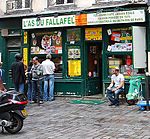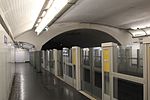Chez Jo Goldenberg restaurant attack

The Chez Jo Goldenberg restaurant attack was a bombing and shooting attack on a Jewish restaurant in the Parisien district of Marais on 9 August 1982 carried out by the Palestinian militant Abu Nidal Organization, a group that splintered from PLO. Two assailants threw a grenade into the dining room, then rushed in and fired machine guns. They killed six people, including two Americans, Ann Van Zanten, a curator at the Chicago Historical Society, and Grace Cutler, and injured 22 others. Mrs. Van Zanten's husband, David, an art history professor at Northwestern University, was among the injured. BusinessWeek later said it was "the heaviest toll suffered by Jews in France since World War II." The restaurant closed in 2006 and former owner Jo Goldenberg died in 2014.Although the Abu Nidal Organization had long been suspected, suspects from the group were only definitively identified 32 years after the attacks, in evidence given by two former Abu Nidal members granted anonymity by French judges.In December 2020 one of the suspects, Walid Abdulrahman Abou Zayed, was handed over to French police (at a Norwegian airport) and flown to France. His period for pre-trial detention has been extended until May 2022.
Excerpt from the Wikipedia article Chez Jo Goldenberg restaurant attack (License: CC BY-SA 3.0, Authors, Images).Chez Jo Goldenberg restaurant attack
Rue Ferdinand Duval, Paris 4th Arrondissement (Paris)
Geographical coordinates (GPS) Address Nearby Places Show on map
Geographical coordinates (GPS)
| Latitude | Longitude |
|---|---|
| N 48.8569 ° | E 2.3598 ° |
Address
Attentat du 9 août 1982
Rue Ferdinand Duval
75004 Paris, 4th Arrondissement (Paris)
Ile-de-France, France
Open on Google Maps











